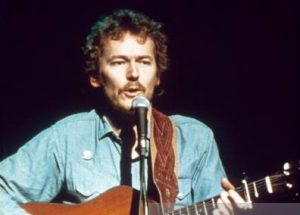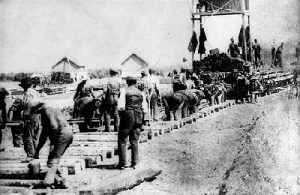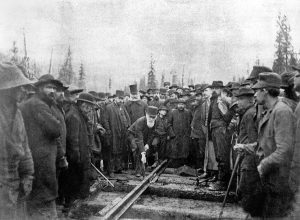 It’s the sort of thing I do mindlessly. Pull up next to the pumps. Pop the gas tank cover lever next to my driver’s seat. Walk around to the pump. Pick up the nozzle. Press the self-serve request for gas. And fill my gas tank. Then, just as mindlessly, I walk into the gas bar booth to pay for my gas. Only this time, when I entered the booth, I was almost bowled over by the music blaring inside.
It’s the sort of thing I do mindlessly. Pull up next to the pumps. Pop the gas tank cover lever next to my driver’s seat. Walk around to the pump. Pick up the nozzle. Press the self-serve request for gas. And fill my gas tank. Then, just as mindlessly, I walk into the gas bar booth to pay for my gas. Only this time, when I entered the booth, I was almost bowled over by the music blaring inside.
“There was a time in this fair land when the railroad did not run,” an unmistakable voice was singing from the booth speakers.
And I nodded my head so the booth attendant would realize I heartily approved. And then I asked him why that music, why that loud?
“Because this month is Canada’s 150th,” he said with a pinch of patriotism. “And after all, it IS the greatest Canadian song ever.”

I nodded again in agreement. Gordon Lightfoot’s “The Canadian Railroad Trilogy” for my money ranks up there. I mean, there are arguably a hundred other songs written in this country that might be considered THE Canadian song. Indeed, on July 1, the Toronto Star published a feature story by Joel Rubinoff in which he eloquently explored the dilemma that Canadian music gurus faced having to choose the top 150 Canadian songs for Canada’s 150 years since Confederation.
The list-makers, Rubinoff pointed out, included such compositions as “River” by Joni Mitchell, “Bobcaygeon” by the Tragically Hip, and “Runnin’ Back to Saskatoon” by the Guess Who. He added that Ian and Sylvia’s “Four Strong Winds” wasn’t included, but Stompin’ Tom Connors’ “Hockey Song” was, while Neil Young’s “Helpless” wasn’t. Some of the others on the list were “Ca-na-da” by Bobby Gimby, “If a Tree Falls” by Bruce Cockburn, “Alberta Bound” by Ian Tyson and “Working Man” by Rita MacNeil. However, every single list had “The Canadian Railroad Trilogy” on it.
At any rate, the gas station attendant and I agreed that Lightfoot’s poem put to music was a classic. And, not being one to ever let a golden opportunity pass (just ask my ever-loving wife and daughters), I offered him (and now you) the story of how “The Canadian Railroad Trilogy” came to be.
In 1966, during a chance meeting between Prime Minister Lester B. Pearson and CBC television producer Bob Jarvis, the prime minister mused about a television extravaganza on the occasion of Canada’s centennial, the next year. Somehow the idea of depicting construction of the Canadian Pacific Railway came up. And Jarvis immediately thought of Gordon Lightfoot and put in the request.

“A month later, Gordon came back,” Jarvis said, “and was asked to play what he’d created, to see how we would react. We were absolutely blown away. He had produced ‘The Canadian Railroad Trilogy.’”
Then, as Jarvis told me years later, he took the work into a CBC TV studio. With Lightfoot singing the song on camera and with a cast of performers acting out the different stages of the trilogy around him, Jarvis put the song to video tape. In his cast of studio CPR re-enactors, Jarvis employed acting extras (bit-players), Yonge Street panhandlers, and even members of the Toronto Argonauts football team portraying the navvies wielding sledgehammers and living in bunk cars in 1885. Broadcast within the program “100 Years Young” on New Year’s Day 1967, Lightfoot’s composition and Jarvis’s studio dramatization, perhaps Canada’s first ever music video, depicted the arduous, but vital building of a national dream from eastern Canada to the Pacific.

“I never had the slightest concern that Gordon would produce something that was memorable,” Jarvis told me. “What I didn’t know, was that it would be such a jewel. I believe ‘The Canadian Railroad Trilogy’ will be sung a hundred years from now. It’s that important a piece of music.”
To get some context for a discussion of THE iconic Canadian song, the Star’s Rubinoff asked Craig Norris, CBC Radio Kitchener’s “Morning Edition” host, for an explanation: “It really comes down to the land,” Norris told him. “I am literally talking about topography, geography. Mountains, rivers and the Canadian Shield.”
My friend in the gas station booth had nailed it, I’d say. And so, I tapped my credit card on the electronic payment device, collected my receipt, and left his booth, as Gordie took us home…
“And many are the dead men too silent to be real…”
Despite its haunting final line, the song left the gas station attendant and me both smiling about the great Canadian moment we’d just shared. I was glad he’d reminded me of Gordon Lightfoot’s iconic song and the story of its creation.
And as I started up my car to pull away, I looked in my rear-view mirror. How appropriate. It was a Canadian Tire gas bar.